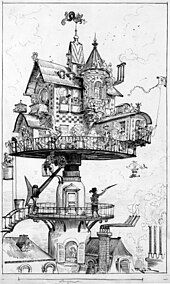Steampunk
Steampunk is a sub-genre of science fiction, fantasy, alternate history, and speculative fiction that came into prominence during the 1980s and early 1990s.[1] Steampunk involves a setting where steam power is still widely used—usually the Victorian era Britain—that incorporates elements of either science fiction or fantasy. Works of steampunk often feature anachronistic technology or futuristic innovations as Victorians may have envisioned them; based on a Victorian perspective on fashion, culture, architectural style, art, etc. This technology may include such fictional machines as those found in the works of H. G. Wells and Jules Verne.
Other examples of steampunk contain alternative history-style presentations of such technology as lighter-than-air airships, analog computers, or such digitalmechanical computers as Charles Babbage and Ada Lovelace's Analytical engine.
Steampunk is sometimes compared to cyberpunk, although apart from the shared origins of the name, they have almost nothing in common. Their time period and level of technology are different and steampunk settings also tend to be less dystopian.[citation needed]
Various modern utilitarian objects have been modded by individual artisans into a pseudo-Victorian mechanical "steampunk" style, and a number of visual and musical artists have been described as steampunk.
Origin

"Maison tournante aérienne" (aerial rotating house) by Albert Robida for his book Le Vingtième Siècle, a 19th-century conception of life in the 20th century
Although many works now considered seminal to the genre were published in the 1960s and 1970s, the term steampunk originated in the late 1980s as a tongue in cheek variant of cyberpunk. It seems to have been coined by science fiction author K. W. Jeter, who was trying to find a general term for works by Tim Powers (The Anubis Gates, 1983); James Blaylock (Homunculus, 1986); and himself (Morlock Night, 1979, and Infernal Devices, 1987)—all of which took place in a 19th-century (usually Victorian) setting and imitated conventions of such actual Victorian speculative fiction as H. G. Wells' The Time Machine. In a letter to science fiction magazine Locus, printed in the April 1987 issue, Jeter wrote:
Dear Locus,Enclosed is a copy of my 1979 novel Morlock Night; I'd appreciate your being so good as to route it Faren Miller, as it's a prime piece of evidence in the great debate as to who in "the Powers/Blaylock/Jeter fantasy triumvirate" was writing in the "gonzo-historical manner" first. Though of course, I did find her review in the March Locus to be quite flattering.Personally, I think Victorian fantasies are going to be the next big thing, as long as we can come up with a fitting collective term for Powers, Blaylock and myself. Something based on the appropriate technology of the era; like "steampunks", perhaps...
© Wikipedia
Subscribe to:
Posts (Atom)